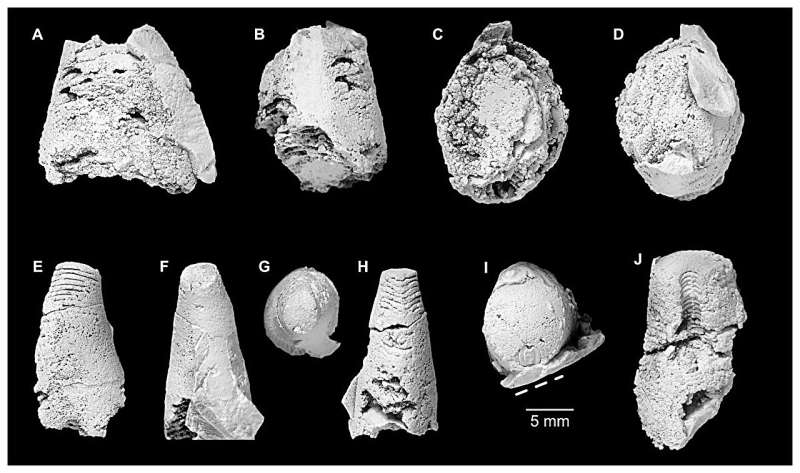This article has been reviewed according to Science X's editorial process and policies. Editors have highlighted the following attributes while ensuring the content's credibility:
fact-checked
peer-reviewed publication
trusted source
proofread
Findings in Australia unveil fossil trove of Cambrian mollusks

A team of researchers led by Alexander Pohle has unveiled a treasure trove of ancient fossils from Queensland, Australia's Black Mountain. The findings, published in PeerJ, shed new light on the complex three-dimensional siphuncle morphology of Plectronoceratids, a pivotal group of mollusks from the latest Cambrian period.
The study surpasses the entirety of previously documented Plectronoceratid fossils, presenting over 200 well-preserved specimens. These fossils, meticulously collected by the late Mary Wade and her team during the 1970s and 1980s, offer unprecedented insights into the intricate structures of these ancient creatures.
Pohle's team focused on specimens from the lower Ninmaroo Formation at Black Mountain, meticulously examining the three-dimensional morphology of the siphuncle. This comprehensive analysis revealed a remarkably intricate siphuncular structure, challenging previous interpretations based on longitudinal sections and prompting a major revision of the taxonomic classification within the order Plectronoceratida.
Of particular note is the discovery of Sinoeremoceras marywadeae sp. nov., a new species named in honor of Mary Wade. This species, characterized by its highly oblique siphuncular segments and elongated septal neck, represents a significant addition to the cephalopod evolutionary tree. Moreover, the study advocates for a revised taxonomy, consolidating multiple species, genera, families and even one order under the Plectronoceratida.
Pohle expressed his gratitude to Mary Wade, whose dedication to specimen collection and preparation paved the way for this groundbreaking research. "Would it not be for her, these faunas would still largely be unknown," said Pohle. The team hopes that their work honors Wade's legacy, acknowledging the invaluable contributions she made to paleontological science.
As the scientific community delves deeper into the origins of cephalopods, Pohle's team emphasizes the significance of further exploration and advanced imaging techniques. They advocate for the use of 3D reconstructions, such as µCT scans or serial grinding tomography, to unlock new dimensions of understanding in research on Palaeozoic cephalopds.
The publication of this study marks a pivotal moment in our quest to unravel the mysteries of ancient marine life. With each fossil unearthed, we inch closer to a comprehensive understanding of Earth's prehistoric past.
More information: Plectronoceratids (Cephalopoda) from the latest Cambrian at Black Mountain, Queensland, reveal complex three-dimensional siphuncle morphology, with major taxonomic implications, PeerJ (2024). DOI: 10.7717/peerj.17003
Journal information: PeerJ
Provided by PeerJ





















